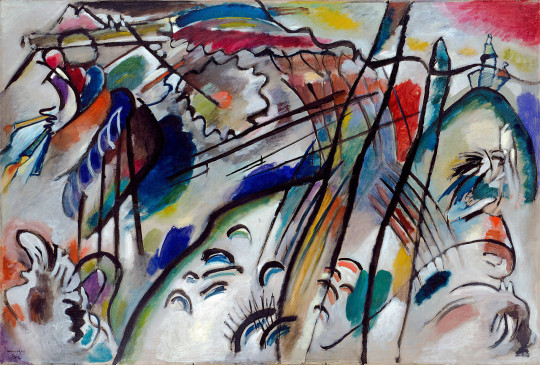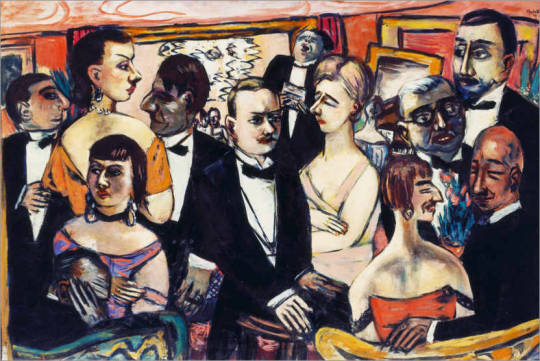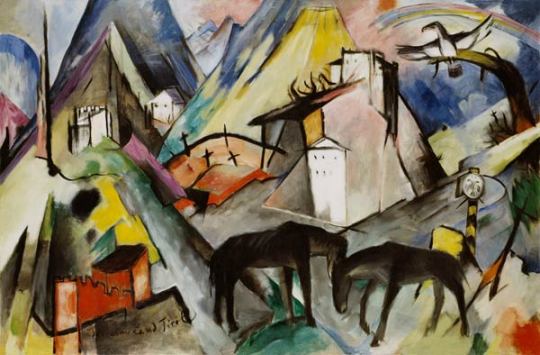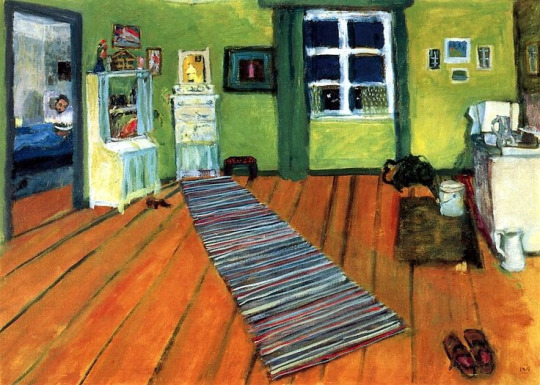#ludwig reiter
Text

i-D April 2001 photos Kevin Davies styling Marcus Ross
#id magazine#kevin davies#marcus ross#r newbold#burro#2001#2000s#aemkei#freakshow#levis red#urban action#one true saxon#carol christian poell#paul smith#calvin klein#urban action#ludwig reiter#bond international#spiewak
38 notes
·
View notes
Photo

https://www.permanentstyle.com/2023/06/rapid-multiple-borrowings-riviera-style-today.html
Rapid multiple borrowings: Riviera style today
11 notes
·
View notes
Photo





Cinq œuvres et un mouvement #5
L’Expressionisme
Wassily Kandinsky - Improvisation 28 (second version) (1912)
Max Beckmann - La société de Paris (1931)
Ernst Ludwig Kirchner - Rue Berlin (1913)
Franz Marc - Le pauvre pays du tyrol (1913)
Gabriele Münter - Intérieur (1908)
L’expressionnisme est apparu au début du XXème siècle en Europe du Nord et atteignit son apogée entre 1905 et 1920. Il est caractérisé par un langage émotionnel véhément et spontané, remontant à Van Gogh, Edward Munch et James Ensor. Les artistes de ce mouvement explorèrent la destruction des sentiments authentiques par une société qui, à leur avis, devait être “purifiée” et ils expriment cette exploration par des images simplifiées, déformées, brutalisées ou abstraites.
Très présent en Allemagne, il fut porté par 2 groupes d’artistes :
- Die Brücke (= le Pont), groupe fondé à Dresde en 1905, composé de 4 étudiants : Fritz Bleyl, Erich Heckel, Ernst Ludwing Kirchner et Karl Schmidt-Rottluff. Die Brücke rejeta l’héritage classique et se tourna vers la nature et le primitif pour renouveler l’art allemand. Leur expressionnisme était lié à une étude de l’identité et des traditions allemandes. Le groupe se déplace à Berlin en 1910 et se dissout 3 ans plus tard.
- Der Blaue Reiter (= Le cavalier bleu), groupe fondé à Munich en 1911 et ses principaux membres sont : Gabriele Münter, Franz Marc, Vassily Kandinsky et Paul Klee. Der Blaue Reiter était plus ouvertement mystique et visait à relever la vérité spirituelle cachée dans l’univers. Il utilisait une gamme de couleurs plus variée et plus subtile que les artiste de Die Brücke.
Le groupe se dissout à l’arrivée de la première guerre mondiale.
#5 oeuvres et 1 mouvement#expressionisme#wassily kandinsky#max beckmann#ernst ludwig kirchner#franz marc#gabriele munter#gabriele münter#die brücke#der blaue reiter#berlin#dresde#peinture#painting#expressionnism
4 notes
·
View notes
Text
i am not your friend by ludwig except the video title is we should know less about each other and instead of ludwig in the thumbnail its me addressing ludwig because we really should know less about him than we fucking do
1 note
·
View note
Text

Reiter an südlicher Küste (c. 1920), Ludwig von Hofmann
593 notes
·
View notes
Text

Nicolò and Yusuf as ‘Sea Riders’ (but make it crusades era).

Inspired by Ludwig von Hofmann’s “Reiter am Strand” ca. 1890 — (look at that and tell me it’s not Nicky!)
Ludwig von Hofmann was a German artist (1861-1945), and he sure liked his nude riders… (Seriously, there are dozens…)
Looking at his art, I couldn’t help but imagine Nicolò and Yusuf riding and playing in the surf like a pair of boys.
And that’s why you have Yusuf, too… 😘
PS: Happy birthday TOG fandom!! 🥳🥳🥳
If Netflix won’t give us flashbacks, we’ll make our own.
#the old guard#tog fanart#the old guard fanart#joe x nicky#joe/nicky#nicolo di genova#yusuf al kaysani#kaysanova#immortal husbands#tog2#ha we wish#tog anniversary#inspired by art#ludwig von hofmann#tog art#nicky di genova#my art#fanart#artists on tumblr
238 notes
·
View notes
Text
July 18: World Listening Day
Bowser, contrary to popular belief, knew how to listen to people- he just usually doesn’t want to.
The few he actively did listen to were few, and predictably encapsulated his whole family and, eventually, Luigi.
It was hardly rare for his husband to need him to listen- after all, Luigi is still one of the most anxious beings Bowser knew.
Compared to him, it was an entirely different story with himself.
Key on ‘was’.
Because, regardless of what reputation Bowser had for listening, Luigi seemed determined to snag the crown for King of Listeners.
It could be a brief conversation with Ludwig about musical composition, a four-hour-long period of letting Wendy rant about the latest fashion choices of her favorite designers, or even the life story of a Koopa Troopa that has just entered the army.
It was just a matter of time before he himself was listened to.
Sure, he had a whole army who listened to his commands and a troop of kids who sometimes followed his rules. But to have someone who listened to his doubts? His insecurities and concerns- especially as he stumbles into a newly peaceful rule?
Invaluable.
(Which describes Luigi well, to be honest).
And he hadn’t realized HOW valuable it was until Bowser hit a snag over new workforce policies.
The funny thing was that Luigi had come an hour in with his struggle on finding alternatives to the more lucrative raid parties.
It took one look at him for Luigi to plant himself on the guest chair and implored him to tell him about it.
And of course, Bowser was incredulous! There didn’t seem to be much point in reiterating a problem that they both knew but-
Damn his puppy eyes.
So Bowser humors him, telling him from the beginning of what has been impacted by the peace treaty, the current excursions by raid party members who have lost well-paying jobs, etcetera, etcetera…
And Luigi is able to listen too! Maybe it was his voice that was keeping him awake or the focused look he gave as he clarified points of the topic that had Bowser frustrated because of how this whole problem was stupidly escalating.
After all, why couldn’t they just apply for the increasingly important border jobs….
And realization hit him like a runaway clown car.
Before he knew it, he had a proposal and Royal Announcement vetted out for overview and a quietly happy husband vibrating in his seat as Bowser finished the last ink stroke.
“Did it hel-“
And of course, he kissed him- how else would he thank his wonderful life-light?
#bowuigi#NATIONAL HOLIDAY#did you know#that apparently programmers do the same with rubber ducks#to find a problems with a code that doesn't work#it's true#the internet told me
55 notes
·
View notes
Text
"Government policies try to prevent the emergence of serious unemployment by credit expansion, i.e., inflation. The outcome was rising prices, renewed demands for higher wages and reiterated credit expansion; in short, protracted inflation."
- Ludwig von Mises
7 notes
·
View notes
Note
I wish ranboo had a spine and wasn't folding to every small thing his fans feel like virtue signalling because its obvious he does care somewhat but hes always walking on eggshells about things. like, he accidentally posted an ai image, and then went out of his way to commission a real artist for something to make up for it. that's genuine. streams where apologizes and "takes accountability" for edgy 13 year olds posting racist shit in defense of him on twitter, are the opposite of genuine. at least dreams endless apologies were for real shit when he was actually being some ist/phobic every month 💀
i think the funny thing is that despite touting this image of being knowledgeable and always learning and shit like...he isn't. i highly doubt he's ever actually put in the time and effort to learn about an issue that he isn't being "cancelled" for. and listen i'm not saying i'm perfect either, i mean get lots of info from news podcasts (washington post, nyt, npr, pod save america) and hasan's yt (let me reiterate: info not opinions) because i have time to listen to stuff in the background when i'm walking somewhere or doing something but i don't have time right now to sit down and learn about something if it's not for a class or the MCAT. and that's totally fine! not everyone has time for that stuff (i mean ranboo probably does). but the thing is it's SO disingenuous to be like "im woke! i learn about stuff!" when the only time you do is to avoid getting canceled. like take a page out of ludwig's book and go read the wikipedia page on american imperialism why don't you
7 notes
·
View notes
Text

Ludwig von Hofmann - Reiter an südlicher Küste, ca.1920
6 notes
·
View notes
Text
[E. How are the essential directions of Existenz, which form the anthropological structures of its entire history, constituted? - cont'd]
[1. The first thing to note is that the three polarities we have described (epic, lyric, tragic), even though each has its independent status, one at least appears more fundamental - cont'd]
b. What is the anthropological privilege of this vertical dimension? Most of all, it brings out, almost nakedly, the structures of temporality.
i. Horizontal opposition of the near and the far [of epic expression] exhibits time only in the chronology of spatial progression. Time unfolds only between
a point of departure
a point of arrival
and is wholly exhausted in the journeying: and when it renews itself, it does so in the form of repetition:
return
another departure
In this existential direction, time is in as essence nostalgic. It tries
to close around itself
to recommence by linking up again to its beginning
The time of the epic is circular or reiterative.
ii. In the opposition of the light and the dark [of lyric expression], too, time is not authentic temporality, but
a rhythmic time marked by oscillations
a seasonal time where absence is always a pledge of return, and death, the pledge of resurrection
iii. With the movement of ascent and fall [of tragic expression], on the contrary, one can grasp temporality in its primitive meaning.
– Michel Foucault, Dream, Imagination and Existence: An Introduction to Ludwig Binswanger's Le rêve et l'existence (part IV: Ce qui pèse to l'homme, c'est le rêve [What weighs on man is the dream] — Bernanos), 1954, translated by Forrest Williams
1 note
·
View note
Text
INDEX
CLASSICO E ROMANTICO
William Blake, Newton
Jöhan Heinrich Füssli, L'incubo
Étienne-Luoise Boullée, Progetto per il cenotafio di Newton
Claude-Nicolas Ledoux, Casa delle Guardie campestri
John Constable, La chiusa
e il mulino di Flatford
William Turner, Mare in tempesta
Francisco Goya, Fucilazione
Jacques-Louis David, La morte di Marat
Antonio Canova, Monumento di Maria Cristina d’Austria
Jean-August-Dominique Ingres, La bagnante di Valpingon
Théodore Géricault, La zattera della Medusa
Eugène Delacroix, La Libertà guida il popolo
Lorenzo Bartolini, Monumento funebre della contessa Zamoyska
François Rude, Rilievo dell'Arco di trionfo di Parigi
Camille Corot, La cattedrale di Chartres
Théodore Rousseau, Temporale; veduta della piana di Montmartre
Honoré Daumier, Vogliamo Barabba
Constantin Guys, Per la strada
Honoré Daumier, Il vagone di terza classe
François Millet, L’Angelus
Camille Pissarro, Sentiero nel bosco in estate
LA REALTA' E LA COSCIENZA (l’Impressionismo; La fotografia; Il Neo-impressionismo; Il Simbolismo; L’architettura degli ingegneri)
Gustave Courbet, Ragazze in riva alla Senna (Estate)
Edouard Manet, Le déjeuner sur l'herbe
Alfred Sisley, Isola della Grande Jatte
Claude Monet, Regate ad Argenteuil;
Claude Monet, La Cattedrale di Rouen
Auguste Renoir, Le Moulin de la Galette
Edgar Degas, L'absinthe
Paul Cézanne, L'asino e i ladri
Paul Cézanne, La casa dell'impiccato ad Auvers (Non Aversa)
Paul Cézanne, I giocatori di carte
Paul Cézanne, La montagna Sainte-Victoire
Georges Seurat, Una domenica pomeriggio all’isola della Grande-Jatte
Paul Signac, Ingresso del porto a Marsiglia
Paul Gauguin, Te Tamari No Atua
Vincent van Gogh, Ritratto del postino Roulin
Henri de Toulouse-Lautrec, La toilette
Henri Rousseau detto il Doganiere, La Guerra
Odilon Redon, Nascita di Venere
Gustave Moreau, L'apparizione
Pierre Bonnard, La toilette del mattino
Auguste Rodin, Monumento a Balzac
Medardo Rosso, Impressione di bambino davanti alle cucine economiche
I pittori della cerchia di Mallarmé
Edouard Vuillard, La pappa di Annette.
James MeNeill Whistler, Notturno in blu e oro: il vecchio ponte di Battersea
L' OTTOCENTO IN ITALIA, IN GERMANIA, IN INGHILTERRA
1. Giovanni Fattori, In vedetta
IL MODERNISMO (Urbanistica e architettura moderniste; Art Nouveau; La pittura del Modernismo; Pont-Aven e Nabis)
1. Antoni Gaudí, Casa Milá a Barcellona
2. Adolf Loos, Casa Steiner a Vienna
3. Antoni Gaudi, Il Parco Güell a Barcellona
L’ARTE COME ESPRESSIONE (Espressionismo; La grafica dell’Espressionismo)
1. Edvard Munch, Pubertà
André Derain, Donna in camicia
Ernst Ludwig Kirchner, Marcella
Henri Matisse, La danza
Emil Nolde, Rose rosse e gialle
Oskar Kokoschka, Chamonix, Monte Bianco
L’EPOCA DEL FUNZIONALISMO (Urbanistica, architettura, disegno industriale; Pittura e scultura; Der blaue Reiter; L’avanguardia russa; La situazione italiana; École de Paris; Dada; Il Surrealismo; La situazione in Inghilterra; La situazione italiana: Metafisica, Novecento, anti-Novecento)
Le Corbusier, Villa Savoye a Poissy
Le Corbusier, Cappella di Nötre-Dame-du-Haute a Ronchamp
Walter Gropius, La Bauhaus a Dessau
Ludwig Mies van der Rohe, Plastico di un grattacielo in verro per Chicago
Ludwig Mies van der Rohe, Seagram Buildings a New York
Tre progetti per il Palazzo dei Soviet. Le Corbusier e Pierre Jeanneret,
Walter Gropius, Bertold Luberkin,
Teo van Docsburg e Hans Arp, Cinema-ristorante L'Aubette a Strasburgo.
Thomas Gerrit Rietveld, Poltrona con elementi in nero, rosso, blu
Pier Mondrian, Composizione in rosso, giallo, blu
Aivar Aalto, Sanatorio a Paimio - Poltrona
Frank Lloyd Wright, Casa Kaufmann a Bear Run
Pablo Picasso, I saltimbanchi; Les demoiselles d’Avignon; Natura morta spagnola
Georges Braque, Narura morta con l’asso di fiori
Robert Delaunay, Tour Eiffel
Juan Gris, Natura morta con fruttiera e bottiglia d’acqua
Georges Braque, Natura morta con credenza: Café-bar
Marcel Duchamp, Nu descendant un escalier n. 2
Umberto Boccioni, Forme uniche nella continuità dello spazio
Giacomo Balla, Automobile in corsa
Vasili; Kandinsky, Primo acquerello astratto; Punte nell'arco
Paul Klee, Strada principale e strade laterali
Anton Pevsner, Costruzione dinamica
Naum Gabo, Costruzione nello spazio; Il cristallo
Fernand Léger, Composizione con tre figure
Joan Miró, La lezione di sci; Donne e uccello al chiaro di luna
Giuseppe Terragni, Progetto dell'Asilo Sant'Elia a Como
Atanasio Soldati, Composizione
Constantin Brancusi, La Maiastra
Amedeo Modigliani, Ritratto di Léopold Zborowski
Georges Rouault, Cristo Deriso
Marc Chagall, A la Russie, aux anes et aux autres
Pablo Picasso, Guernica
René Magritte, La condizione umana Il
Man Ray, Motivo perpetuo
Henry Moore, Figura sdraiata
Alexander Calder, Mobile
Ben Nicholson, Feb. 28-53 (Vertical Seconds)
Francis Bacon, Studio dal ritratto di Innocenzo X di Velázquez
Diego Rivera, L'esecuzione dell'imperatore Massimiliano
David Alfaro Sigueiros, Morte all'invasore
Giorgio De Chirico, Le Muse inquietanti
Carlo Carrà, L'amante dell'ingegnere
Alberto Savinio, Nella foresta
Osvaldo Licini, Amalasunta su fondo blu
Giorgio Morandi, Natura morta con fruttiera
7. LA CRISI DELL'ARTE COME "SCIENZA EUROPEA" (Urbanistica e architettura; La ricerca visiva; La pittura negli Stati Uniti)
Ellsworth Kelly, Verde, blu, rosso
Morris Louis, Gamma Delta
László Moholy-Nagy, Composizione Q XX
Julius Bissier, 25 settembre 1963?
Josef Albers, Omaggio al quadrato
Arshile Gorky, Giardino a Sochi
Jean Fautrier, Nudo
Jean Dubuffet, Orateur
André Masson, Les Chevaliers
Hans Hartung, Composizione
Jackson Pollock, Sentieri ondulati
Mark Rothko, Rosso e blu su rosso
Albero Burri, Sacco B.
Antoni Tápies, Bianco e arancione
Giuseppe Capogrossi, Superficie 114
Lucio Fontana, Concetto spaziale: attesa
Alberto Giacometti, Figura
Ettore Colla, Officina solare
Mark Tobey, Circus transfigured
Georges Mathieu, Cast
Victor Vasarély, Composizione.
Kenneth Noland, Empireo
Clyfford Still, 1962-D
Emilio Vedova, Plurimo n. 1; Le mani addosso
Robert Rauschenberg, Letto
Mimmo Rotella, Marilyn
Roy Lichtenstein, Il tempio di Apollo
Andy Warhol, Marilyn Monroe
2 notes
·
View notes
Photo

https://www.permanentstyle.com/2023/08/sandals-slides-and-huaraches-open-toe-and-closed.html
Sandals: Slides and huaraches, open-toe and closed
#adret#chamula#Ghiaia#La Botte Gardiane#ludwig reiter#Nisolo#paraboot#Ralph Lauren#Rondini#soloviere
6 notes
·
View notes
Text
“The vibes are off, but they’re off fundamentally because they focus only on feelings and emotional connections that have already existed. They don’t provide or imagine pathways to new futures; they allow only for an understanding of what feels good or bad based on experiences that have already happened, things that have already been seen.
In other words, “vibes” are similar to the approximations that machine learning systems use, and the two feed off of each other synergistically. The situation is precisely encapsulated by Goodhart’s Law: “When a measure becomes a target, it ceases to be a good measure.” Content systems optimized by machine learning amplify the repetitive quality of internet content by identifying and recycling the same topics that generate interest and controversy, and the tendency spreads elsewhere in culture, such as in the continuous, unnecessary reiterations of movie franchises like Star Wars or The Matrix. The vibes are gamed until they become stale, and an increasing facility in vibes makes this trend all the more evident and noticeable.”
-Nameless Feeling, Ludwig Yeetgenstein
6 notes
·
View notes
Text

Stefan George &
Kaiserin Elisabeth von Österreich
Stefan George war ein einflussreicher deutscher Dichter, bekannt für sein Gedicht “Die Schwestern” aus dem Zyklus “Der siebente Ring”. Das Gedicht verbindet die Schicksale von Sophie von Alençon und Elisabeth von Österreich, die beide durch Schönheit und tragische Tode gekennzeichnet waren. Georges Werk reflektiert über die Vergänglichkeit und das unausweichliche Ende des Lebens.
In der Welt der Literatur und des kulturellen Gedächtnisses finden sich Elisabeth von Österreich, liebevoll Sisi genannt, und Stefan George in einer zeitlosen Seelenverwandtschaft wieder. Ihre beiderseitige Hingabe zur Poesie und die Suche nach der wahren Schönheit des Lebens verbindet sie über die Grenzen von Raum und Zeit. In Georges literarischem Pantheon, “Der Siebente Ring”, findet Sisi ihren unsterblichen Platz, als eine Muse, die durch ihre Anmut und Tiefe die deutschsprachige Kultur maßgeblich mitgeprägt hat. So schwingt ihr Echo in den Versen Georges weiter, ein Zeugnis ihrer beider unvergänglichen Präsenz in der Walhalla der Dichtkunst.
ELISABETHS BIOGRAFIE
Am 10. September 1898 verlässt Kaiserin Elisabeth von Österreich zur Mittagszeit ein Genfer Hotel, um über den See nach Montreux zu fahren. Ihre Hofdame, die Gräfin Sztáray, gibt später zu Protokoll: “Beim Hotel ‘De la Paix’ kam ein Mann auf uns zu. Unmittelbar vor uns schien er plötzlich zu straucheln; er machte eine Bewegung mit der Hand. Ich glaubte, um sich beim Stolpern aufrecht zu halten. Die Kaiserin sank zu Boden. ‘Es ist mir nichts geschehen’, antwortete sie ruhig. Wir erreichten die Anlegestelle. Plötzlich sagte sie mit erstickender Stimme: ‘Jetzt, Ihren Arm, schnell, bitte!’” Kaiserin Elisabeth stirbt noch auf dem Fährboot. Ein kaum bemerkter Stich mit einer spitzen Tischlerfeile hat sie mitten ins Herz getroffen. Der italienische Anarchist Luigi Lucheni verhehlt seine Befriedigung nicht, ein so prominentes Mitglied der verhassten Aristokratie ermordet zu haben. Elf Jahre nach seiner Verurteilung zu lebenslänglichem Kerker erhängt sich Lucheni in seiner Zelle. Die 60-jährige, von Depressionen geplagte Kaiserin hat mehrmals Todesahnungen geäußert, aber Polizeischutz für ihre Reisen abgelehnt. Zu ihrem Schwager, dem Herzog von Alecon, sagte sie, kurz vor dem Attentat: “Wir werden eines gewaltsamen Todes sterben…”
Elisabeth ist die Tochter des bayerischen Herzogs Maximilian von Wittelsbach und seiner Frau Ludovika. 1853, mit 15 Jahren, wird Sisi, wie man sie allgemein nennt, überraschend zur Gattin des österreichischen Kaisers Franz Joseph auserkoren. Der junge Monarch hat sich Hals über Kopf in die kleine Schwester der ihm zugedachten Helene verliebt. Sisi, später oft als eine der schönsten Frauen ihrer Zeit tituliert, ist fröhlich, witzig und ungestüm. Ihre Jugend hat sie fast ausschließlich auf dem Landsitz in Possenhofen verbracht. Ihr Vater, der nichts von aristokratischer Erziehung hält, hat einmal zu ihr gesagt: “Wenn du und ich nicht Fürsten wären, wären wir zweifellos Reiter in einem Wanderzirkus!” Es ist daher nicht verwunderlich, dass sich die junge Kaiserin nur schwer mit dem Wiener Hofzeremoniell und der strengen Schwiegermutter Sophie zurechtfinden kann. Sisi bringt vier Kinder zur Welt: die Prinzessinnen Sophie und Gisela, Thronfolger Rudolf und Marie Valerie. Sobald diese dem Kindesalter entwachsen sind, nutzt sie jede Gelegenheit, um ihren repräsentativen Pflichten zu entgehen. Franz Joseph toleriert die Lebensweise seiner Frau, die ihre Zeit am liebsten mit Kuraufenthalten und ausgedehnten Reisen verbringt. Elisabeth, die auch gerne Gedichte schreibt, verfällt immer mehr in tiefe Melancholie, die sie ihrem Cousin, dem unglücklichen Ludwig II. von Bayern, seelenverwandt macht. Nach dem Selbstmord ihres Sohnes Rudolf zieht sich die beim Volk beliebte Kaiserin gänzlich vom Hofleben zurück. In den Zeitungen kursieren immer häufiger Meldungen über eine fortschreitende Geisteskrankheit Elisabeths. Sie zeigt aber auch Besonnenheit und Toleranz, nicht zuletzt dadurch, dass sie ihrem vernachlässigten Gatten Franz Joseph den Umgang mit der Burgschauspielerin Katharina Schratt empfiehlt. Sie selbst lässt sich auf der Insel Korfu einen eigenen Palast, das Achilleion, errichten. Viel Zeit verbringt die Kaiserin auch auf Schloss Gödöllö in Ungarn. Ihre Vorliebe für die Magyaren und ihr Nahverhältnis zum Revolutionär Andrassy haben jahrelang immer neuen Gerüchten Nahrung gegeben. Die große Leidenschaft von Elisabeth ist aber zeitlebens das Reisen. Sie führt die Kaiserin im Herbst 1898 nach Genf, wo sie der Tod ereilt.
Quelle: 'Sissi' - Elisabeth von Österreich-Ungarn
1 note
·
View note
